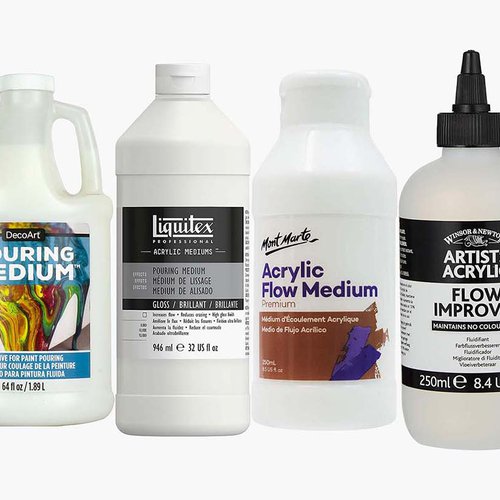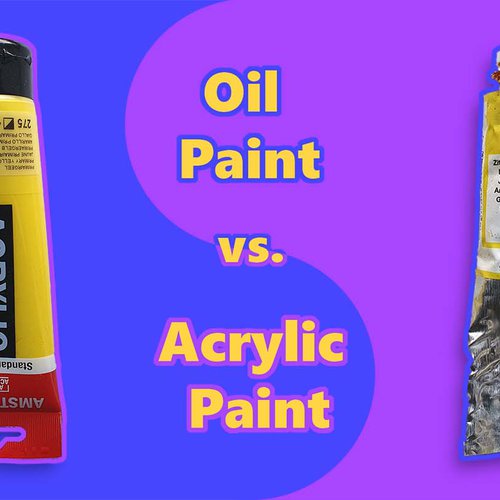The Ultimate Guide to the Best Acrylic Paints of 2025

Welcome to the vibrant world of acrylic paints, where versatility meets brilliance, catering to artists from beginners to professionals. This guide is your essential companion for choosing the best acrylic paints of 2025 to bring your creative visions to life.
Disclaimer: In the name of full transparency, please be aware that this blog post contains affiliate links and any purchases made through such links will result in a small commission for me (at no extra cost for you).
Top Acrylic Paint Brands for 2025
1. Winsor & Newton: Galeria Acrylic vs. Professional Acrylic
Winsor & Newton stands tall in the world of art supplies, renowned for its commitment to quality. In the acrylic paint segment, they offer two exceptional lines: the Galeria Acrylic and the Professional Acrylic.
Galeria Acrylic
These paints are known for their brilliance, smooth consistency, and cheaper price point. Ideal for artists who are just starting out or don't want to spend too much on their paints.
Professional Acrylic
Designed for the discerning artist, these paints boast high pigment strength and a satin finish. They're formulated to offer excellent color retention when thinned, making them perfect for artists who demand the best in color vibrancy and depth.
2. Liquitex: BASICS vs. Professional Heavy Body Acrylic
Liquitex is a trailblazer in the acrylic paint industry, catering to artists at every skill level. Their BASICS and Professional Heavy Body Acrylic lines are particularly noteworthy
BASICS Acrylic
This range is a go-to for beginners and students. Known for its affordability and good pigment quality, BASICS offers a creamy texture, making it great for learning color theory and techniques without a large investment.
Professional Heavy Body Acrylic
Targeted towards more experienced artists, this line boasts high pigment concentration and a thick, buttery consistency. It's ideal for artists who seek greater depth of color and the ability to build texture in their work.
3. Golden: Heavy Body Acrylic and Fluid Acrylics
A favorite among professional artists, Golden offers a range of acrylic paints that are celebrated for their exceptional quality and consistency. Their Heavy Body Acrylic and Fluid Acrylics are particularly noteworthy.
Heavy Body Acrylic
Known for its exceptionally smooth, buttery consistency, this line is ideal for artists who love texture and a tactile painting experience. The high pigment load ensures brilliant colors and excellent permanence.
Fluid Acrylics
These paints offer a highly intense, permanent acrylic with a consistency similar to heavy cream. Perfect for artists who engage in fine detail work, staining, leveling, and watercolor techniques. They provide the same pigment strength as Golden's Heavy Body Acrylics but in a pourable, low viscosity formula.
4. Blick Studio Acrylics
Blick Studio Acrylics offer a fantastic balance between quality and affordability, making them a popular choice for both beginners and intermediate artists. These paints are known for their:
- Consistency and Texture: Medium-bodied, they provide a smooth and buttery application, suitable for a variety of techniques.
- Color Range: Offering a diverse palette, they are great for artists who want to explore a wide spectrum of hues.
- Durability: With good pigment concentration and colorfastness, they ensure long-lasting results for your artworks.
5. Utrecht Artists' Acrylic
Utrecht Artists' Acrylic paints are revered for their handmade quality and rich history. Ideal for artists who appreciate traditional approaches, these paints feature:
- Handcrafted Quality: Made by artists for artists, ensuring high-quality and consistency.
- Pigment Richness: High pigment load provides vivid, enduring colors.
- Versatility: Suitable for a range of techniques, from thick applications to fine details.
6. Sennelier Abstract Acrylics
Sennelier Abstract Acrylics stand out with their innovative packaging and superior quality. They are perfect for artists who are looking for:
- Innovative Design: Packaged in squeezable pouches, they offer ease of use and reduced waste.
- High Pigmentation: Known for intense colors that stay vibrant over time.
- Texture and Consistency: Offering a creamy, thick texture that allows for a variety of artistic expressions.
7. Chroma Atelier Interactive Artists' Acrylic
Chroma Atelier Interactive Artists' Acrylic paints are unique in their ability to rehydrate, offering:
- Extended Working Time: These paints can be reactivated with water, allowing artists to blend and work with them over longer periods.
- High Versatility: Suitable for traditional acrylic painting techniques as well as watercolor-like effects.
- Rich Colors: With a high pigment load, these paints deliver brilliant and lasting colors.
8. Holbein Mat Acrylic Paints
Holbein Mat Acrylic Paints are revered for their exceptional matte finish and highly pigmented colors. They stand out for:
- Matte Finish: Offering a unique, non-reflective finish, ideal for artists who prefer a flat look.
- Consistency and Color Range: These paints have a smooth consistency and a wide range of vivid colors.
- Versatility: Suitable for various techniques and surfaces, making them a flexible choice for different artistic projects.
9. M. Graham 6-Color Acrylic Paint Set
M. Graham's 6-Color Acrylic Paint Set is celebrated for its exceptional quality and artist-grade performance. This brand is a favorite among professionals for its:
- High-Quality Pigments: Offering some of the most vivid and lasting colors available, perfect for artists seeking intensity and brilliance in their work.
- Rich and Vibrant Colors: These paints provide a wide spectrum of hues that retain their vibrancy and offer excellent coverage.
- Smooth Consistency: Known for their creamy texture, these paints allow for easy blending and layering, making them ideal for a variety of techniques.
10. Lascaux Artist Acrylic Paints
Lascaux Artist Acrylic Paints are renowned for their professional quality and durability. They are characterized by:
- Professional Grade: High-quality formulation designed for professional artists.
- Color Brilliance and Permanence: Known for their exceptional color strength and resistance to fading.
- Versatility: These paints perform well across a range of techniques and surfaces, catering to diverse artistic needs.
Understanding Acrylic Paints
The Essence of Acrylic Paints
At its core, acrylic paint is a fast-drying paint made of pigment suspended in acrylic polymer emulsion.
What does this mean for you as an artist? You get a medium that is versatile and adaptable to various techniques and surfaces. Acrylics can be used thickly or thinly, mimicking the effects of oil or watercolor paints, and they can adhere to a wide range of surfaces, from canvas and paper to wood and glass.
Types of Acrylic Paints
Acrylic paints come in various forms, each suited to different artistic needs:
- Heavy Body Acrylics: These have a thick, buttery consistency, ideal for creating textured, impasto effects.
- Fluid Acrylics: Offering a smooth, creamy texture, fluid acrylics are perfect for fine detail work, glazing, and smooth washes.
- Acrylic Gouache: This type blends the characteristics of traditional gouache with the benefits of acrylics, providing a matte finish.
- Interactive/Retarder Acrylics: These paints have a slower drying time, allowing for more extended blending and workability.
Choosing Quality Paints
The quality of acrylic paints can significantly impact your artwork. Here's what to look for:
- Pigmentation: High-quality acrylics have vibrant, consistent colors with good tinting strength.
- Opacity and Transparency: Different paints offer varying levels of coverage, from opaque to transparent.
- Permanence: This refers to the paint's resistance to fading over time. Look for paints with high lightfastness ratings.
Student vs. Professional Grade
Acrylic paints are available in student and professional grades. Student-grade paints are more affordable and have lower pigmentation and a smaller range of colors. Professional-grade paints, however, offer higher pigment concentration, more color choices, and greater durability. Your choice depends on your skill level, project requirements, and budget.
Choosing the Right Acrylic Paint for You
Selecting the perfect acrylic paint can be a pivotal decision in your artistic journey. Understanding the nuances of different paints and how they align with your art style and project needs is crucial. Here are key factors to consider:
1. Viscosity and Texture
- Heavy Body vs. Fluid Acrylics: Heavy body acrylics are thick and retain brush strokes, ideal for impasto techniques. Fluid acrylics, on the other hand, have a smooth, creamy texture perfect for detailed work, glazing, and flat applications.
- Experimentation: Try out different textures to understand which viscosity complements your style of painting.
2. Pigmentation and Color Intensity
- High vs. Low Pigmentation: Professional-grade paints typically have higher pigment concentration, offering more vibrant and enduring colors. Student-grade paints may have lower pigmentation but are more budget-friendly.
- Color Range: Consider the variety of colors available. Some brands offer a wide palette, while others might specialize in more nuanced shades.
3. Permanence and Lightfastness
- Fade Resistance: Look for paints with high permanence ratings, indicating resistance to fading over time. This is especially important for artworks that will be displayed in light-exposed areas.
- Checking Ratings: Most reputable brands provide lightfastness ratings on their packaging, helping you make an informed choice.
4. Surface Compatibility
- Versatile Surfaces: Acrylics can be used on canvas, paper, wood, and more. Check if the paint adheres well to your preferred surface, especially for unconventional ones.
- Absorbency and Texture of Surface: Different paints react differently to various textures and levels of absorbency.
5. Drying Time
- Fast-Drying Nature: Acrylics are known for their quick drying time, which can be both an advantage and a limitation. Consider if you need a slower drying paint for blending and working over longer periods.
- Retarders and Mediums: Some brands offer extenders or interactive paints that can increase working time.
6. Environmental and Health Factors
- Non-Toxic and Eco-Friendly Options: Look for paints that are non-toxic, especially if you are working in a shared or poorly ventilated space. Some brands offer eco-friendly options with natural ingredients.
- Ventilation and Safety: Ensure proper ventilation when painting and consider any allergies or sensitivities to certain paint ingredients.
Choosing the right acrylic paint involves balancing various factors like viscosity, pigmentation, permanence, and your specific project requirements. Don't hesitate to experiment with different brands and types to find your perfect match. Remember, the right paint can not only enhance your artwork but also make the painting process more enjoyable and fulfilling.
Tips and Techniques for Using Acrylic Paints
Mastering acrylic paints involves understanding their unique properties and experimenting with various techniques. Whether you are a beginner or an experienced artist, these tips and methods can enhance your acrylic painting skills.
1. Mixing Colors
- Palette Essentials: Start with a basic palette of primary colors (red, yellow, blue), black, and white. You can mix a wide range of shades from these.
- Color Theory: Familiarize yourself with color theory to create harmonious color schemes and understand the impact of color mixing.
2. Layering and Glazing
- Building Layers: Acrylics dry quickly, allowing you to build layers without long waits. Start with thin layers and gradually build up thickness.
- Glazing Techniques: Use a glazing medium with your paint to create transparent layers, adding depth and richness to your painting.
3. Texturing Techniques
- Impasto: Apply paint thickly with a palette knife or brush to create texture. Heavy body acrylics are ideal for this technique.
- Adding Mediums: Experiment with different mediums (like sand or modeling paste) to create unique textures.
4. Blending and Wet-on-Wet Technique
- Blending Colors: Work quickly to blend colors while the paint is wet, or use a blending medium to extend the drying time.
- Wet-on-Wet: Apply wet paint onto wet paint to achieve smooth, blending transitions. This technique is great for backgrounds and skies.
5. Dry Brushing
- Creating Texture: Use a dry brush with minimal paint to lightly brush over the canvas. This technique highlights texture and creates a dynamic, layered effect.
6. Underpainting and Sketching
- Starting with an Underpainting: Begin your painting with a monochromatic underpainting to establish values and composition.
- Sketching First: Sketch your composition with pencil or thin acrylic wash before applying thicker layers of paint.
7. Experiment with Different Tools
- Beyond Brushes: Experiment with different tools like sponges, toothbrushes, or even your fingers to apply paint in unique ways.
8. Maintaining Paint Consistency
- Preventing Paint from Drying: Keep your palette moist using a palette wetting spray or a stay-wet palette to extend the usability of your paints.
9. Safety and Clean-Up
- Safe Practices: Although acrylics are water-based, ensure proper ventilation and wear protective gear if needed.
- Cleaning Up: Clean brushes with soap and water immediately after use to maintain their quality.
Acrylic painting is a journey of exploration and creativity. By experimenting with these tips and techniques, you can discover new ways to express yourself and bring your artistic visions to life. Remember, there are no strict rules in art |???| feel free to experiment and find what works best for you!
Maintaining and Storing Acrylic Paints
Proper care and storage of your acrylic paints are essential for preserving their quality and extending their lifespan. Here are some best practices to help you maintain your acrylic paints:
1. Proper Storage of Paint Tubes and Bottles
- Cool and Dry Environment: Store your acrylic paint tubes and bottles in a cool, dry place to prevent them from drying out or separating.
- Upright Position: Keep tubes and bottles upright to avoid leaks and to keep the paint near the opening for easy access.
2. Preventing Paint Drying and Skinning
- Tight Seals: Ensure that paint lids and caps are tightly closed after use to prevent air from drying out the paint.
- Preventing Skinning: In jars or pots, a thin layer of plastic wrap under the lid can help prevent the formation of a skin on the paint surface.
3. Reviving Dried Paints
- Slight Drying: If the paint has begun to dry but is still pliable, you can try mixing in a small amount of water or acrylic medium to restore its consistency.
- Completely Dried Paint: Once acrylic paint is fully dried, it's difficult to reactivate. However, dried paint can still be used for collage or as texture in new projects.
4. Palette Maintenance
- Wet Palettes: Use a wet palette for longer painting sessions to keep your paints moist and workable.
- Regular Cleaning: Clean your palette after each session to prevent dried paint from accumulating.
5. Brush Care
- Immediate Cleaning: Clean your brushes immediately after use with water and mild soap to prevent the acrylic paint from drying on the bristles.
- Proper Drying: After washing, reshape the brush head and allow it to dry horizontally to prevent water from loosening the glue in the ferrule.
6. Environmental Considerations
- Eco-Friendly Disposal: Be mindful of environmental impact. Avoid rinsing large amounts of paint down the drain. Instead, wipe off excess paint with a rag or paper towel before washing brushes.
- Recycling and Reusing: Consider ways to reuse empty paint tubes or bottles and recycle when possible.
Taking care of your acrylic paints and painting tools not only ensures that they last longer but also makes your painting sessions more enjoyable and efficient. A little effort in maintenance can go a long way in preserving the quality and vibrancy of your paints, allowing you to create beautiful art for years to come.
Conclusion
As we reach the end of our exploration into the vibrant and versatile world of acrylic paints, it's clear that the possibilities are as limitless as your creativity. From the buttery richness of heavy body paints to the fluid elegance of acrylic inks, each type and brand of paint offers unique opportunities to express your artistic vision.
Remember, the journey of an artist is one of constant learning and experimentation. Whether you're a beginner dabbling in color for the first time or a seasoned professional refining your techniques, the right acrylic paint can make all the difference in your work. The brands and tips highlighted in this guide are your starting points, your invitations to play, explore, and discover new realms of artistic expression.
So, as you stand before your canvas with brush in hand, remember that each stroke is a reflection of your unique perspective. The paints you choose are your allies, helping to bring your imagination to life. Embrace the diversity of acrylic paints, experiment with different styles, and most importantly, enjoy the process of creating something truly yours.
Art is a journey, and with acrylics, you have the perfect companions to accompany you on this vibrant and exciting path. Happy painting!







Be the first to comment!
Comments
There are no comments yet.